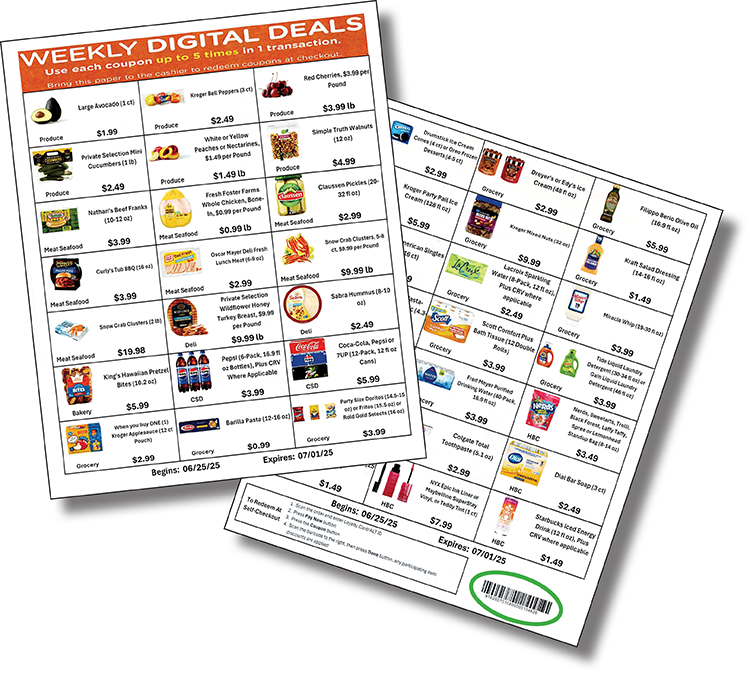Kroger Makes It Easier to Use Digital-Only Coupons
Last updated July 3, 2025
Grocery shoppers can celebrate a small victory this week after Kroger, one of the nation’s largest supermarket chains, improved its much-maligned digital coupon policy at some of its stores.
Listen to audio highlights of the story below:
Three years ago, a coalition of consumer groups urged a dozen of the largest U.S. supermarket chains to “stop discriminating against senior citizens and low-income shoppers” who are unable to take advantage of in-store digital-only discounts because they don’t have reliable internet access or own smartphones. As a result, these shoppers are forced to pay higher grocery prices than their more tech-savvy counterparts.

Kroger’s solution is to now provide printed “Weekly Digital Deals” at store entrances or customer service desks. At checkout, customers can sign a single barcode on the sheet to receive the discounts.
Unfortunately, not all Kroger-owned brands are participating in this effort. Kroger operates Food 4 Less, Foods Co., Fred Meyer, Fry’s, Harris Teeter, King Soopers, Mariano’s, Metro Market, Pick ’n Save, QFC, Ralphs, and several other smaller supermarket chains.
I visited QFC and Fred Meyer stores in Seattle and found the “weekly digital deals” flyers at the entrance to both stores. When I called a few Mariano’s locations in the Chicago area, I was told the digital deals flyers are available there. But when I called Harris Teeter stores in Maryland staff told me they don’t offer a similar offline option.
Before the policy change, Kroger required shoppers to use its app or website to select each digital-only coupon they wanted to use, then store them on their app or loyalty card to receive the advertised discounts.
“Kroger is finally doing something good for consumers who have been cut out of being able to use digital coupons,” Edgar Dworsky, publisher of Consumerworld.org, told Checkbook. “They created what I call a ‘super coupon,’ a little handout sheet in the store that has all their digital coupons and specials, all on one sheet and a single barcode. It’s so simple, why didn’t they do this sooner?”
Similarly, last year, Stop & Shop, a regional supermarket chain in the Northeast, made it easier for all shoppers to take advantage of its digital coupons by installing coupon kiosks at the front of its stores. Customers simply scan their loyalty cards or enter their phone numbers at the “Savings Station,” and all that week’s advertised digital coupons are automatically loaded onto their accounts.
Kroger and Stop & Shop still require customers to take extra steps to get the lowest prices—and shoppers must figure out how to unlock these savings. But it’s an improvement.
Most other mega-grocery chains, including Albertson’s, have stuck to a digital-divide strategy. Albertsons owns Andronico’s, Acme, Haggen, Jewel-Osco, Lucky, Randall’s, Safeway, Shaw’s, Star, Vons, and United Supermarkets.
‘An Unfair Hardship’
As Checkbook previously reported, digital coupons can be difficult or impossible for some customers to use. One Checkbook subscriber said digital coupons at Fred Meyer “only work 60 percent of the time.” Another complained that they are “overcharged regularly at Harris Teeter for sale items.”
Even when the discounts work, shoppers without smartphones, computers, or tech skills are effectively shut out of advertised savings. According to a 2021 Pew Research Center report, nearly 25 percent of adults aged 65 and older do not use the internet, and roughly 30 percent of low-income households (earning under $30,000 annually) lack reliable broadband access.
“The extra financial burden placed on these vulnerable consumers is an unfair hardship,” the consumer groups told the grocery giants.
Kroger has yet to publicly announce its new coupon program or announce which sub-brands will participate. Checkbook asked Kroger for details, but the company did not respond.
But during a June 20 quarterly earnings call with investors, Kroger executives discussed digital coupons and CEO Ron Sargent said the company was “working to make sure that our promotional offers are simpler, easier to access by all customers.”
CFO David Kennerly added, “Rather than a customer having to get out their phone to get a digital coupon in-store, we’re trying to make the customer experience in-store much easier for them.”
Should Digital Coupons Be Banned?
Legislators in Connecticut, Illinois, New Jersey, New York, and several cities are considering banning digital coupons.
The San Diego City Council made national news earlier this year when it passed an ordinance requiring grocery stores there to offer shoppers “an equivalent in-store alternative” for all publicly available digital offers. The ordinance takes effect in October.
Food Costs Continue to Rise
Americans are spending a greater portion of their income on food than they have in decades. Coupons can help lower spending, but the digital divide has been a hindrance for a growing part of the population.
For shoppers living on fixed incomes—such as many retirees or those receiving disability benefits—even small savings of $.50 or $1 per item can add up significantly over time. In rural areas, where fewer grocery options exist, shoppers can’t just go to a competing store with more accessible discounts.
“Consumer advocates have been lobbying stores for the past three years, so it’s really good to see a big chain like Kroger get their act together and make digital coupons easier,” Dworsky said. “Now it's Albertson’s turn.”
Related:
- From Checkbook: Grocery Stores and Delivery Services
- Consumer Reports: Investigation Finds Kroger Stores Overcharging Shoppers on Sale Items
Contributing editor Herb Weisbaum (“The ConsumerMan”) is an Emmy award-winning broadcaster and one of America's top consumer experts. He has been protecting consumers for more than 40 years, having covered the consumer beat for CBS News, The Today Show, and NBCNews.com. You can also find him on Facebook, Blue Sky, X, Instagram, and at ConsumerMan.com.


